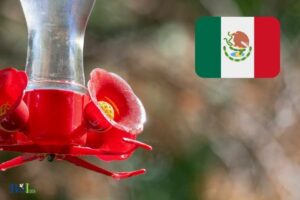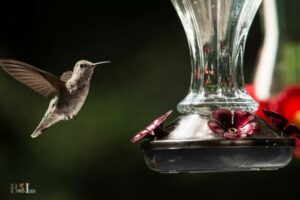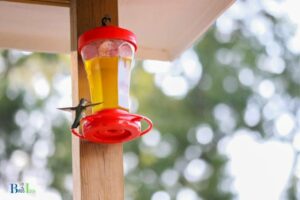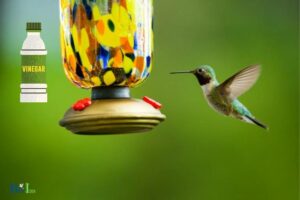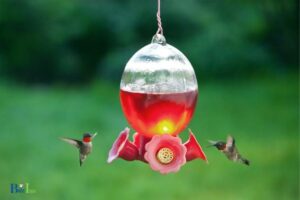Hummingbird Nectar Recipe Plus Feeder Tips: Consists
The ideal hummingbird nectar recipe consists of 4 parts water to 1 part white granulated sugar, creating a solution that closely mimics natural flower nectar. Combine the sugar and water in a saucepan, heat it until the sugar dissolves, and then let it cool before using it in a feeder.
Hummingbirds get their energy from nectar, which provides them with the necessary carbohydrates and nutrients. The simple recipe mentioned above mimics the sugar content of natural nectar found in flowers.
It’s important not to use honey, artificial sweeteners, or red dye, as these substances can be harmful to the birds.
To ensure the health and wellbeing of hummingbirds visiting your feeder, it’s crucial to maintain cleanliness and provide fresh nectar. Clean the feeder with a mild soap solution and rinse it thoroughly at least once a week – more frequently in hot weather.
Position the feeder in a shaded area to prevent the nectar from spoiling quickly. Additionally, keep an eye out for ants and bees that might be attracted to the feeder, and take appropriate measures to deter them if necessary.
7 Detailed Recipe and Feeder Tips for Hummingbird Nectar
| Hummingbird Nectar Recipe | Instructions | Feeder Tips |
| 1 part sugar, 4 parts water | 1. Combine 1 cup of sugar and 4 cups of water in a pot. | 1. Use feeders with red accents to attract hummingbirds. |
| 2. Stir until sugar dissolves completely. | 2. Clean and refill feeders every 2-3 days to prevent mold and bacteria growth. | |
| 3. Bring mixture to a boil for a few minutes, then remove from heat. | 3. Place feeders in a shaded area to prevent nectar from spoiling rapidly. | |
| 4. Let the nectar cool to room temperature. | 4. Hang feeders near flowers that attract hummingbirds, such as trumpet vine or fuchsia. | |
| 5. Fill clean hummingbird feeders with nectar, leaving some space for expansion. | 5. Avoid using pesticides near feeders, as these can be harmful to hummingbirds. | |
| 6. Store any remaining nectar in the refrigerator for up to 2 weeks. | 6. Have multiple feeders to reduce competition among hummingbirds. | |
| 7. Use an ant moat or pest deterrent to keep insects away from the nectar. |
Key Takeaway
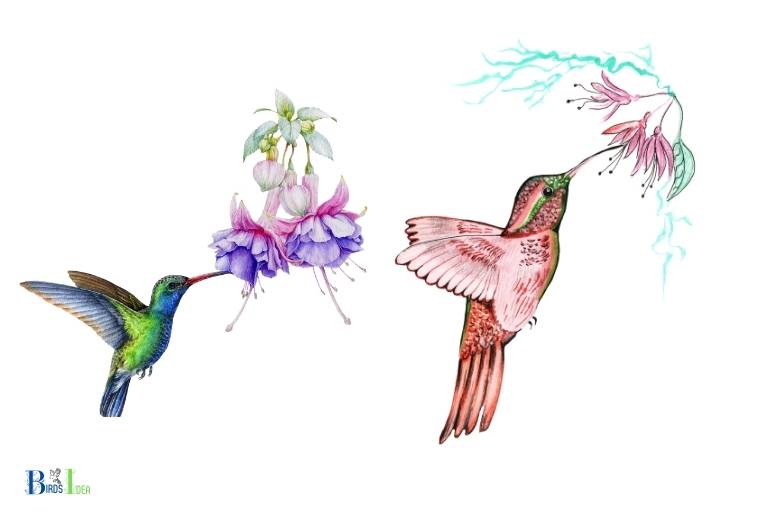
Five Facts About: Hummingbird Nectar and Feeder Tips
Preparing The Perfect Nectar Recipe For Hummingbirds
Hummingbirds are fascinating creatures with unique feeding habits. They require the right kind of nectar to survive, and as a homeowner, one way to ensure their survival is by providing them with homemade nectar.
In this post, we’ll explore the importance of hummingbird nectar, its nutritional value, the ingredients required, simple steps to make homemade nectar, and tips for properly storing it.
The Importance Of Hummingbird Nectar And Its Nutritional Value
Hummingbirds primarily feed on nectar, which provides them with the energy they need to fly and maintain their active lifestyle. Nectar offers these birds essential nutrients such as carbohydrates, energy, and vitamins.
Providing a steady supply of nectar will help the birds build their energy levels and maintain their health.
It’s essential to use the right ingredients to provide the birds with the necessary nutrients.
What Ingredients Do You Need To Make Hummingbird Nectar?
To make the perfect nectar for hummingbirds, you need just two ingredients: water and granulated white sugar. You might think that other sweeteners like honey or brown sugar would make a great substitute, but that’s not the case.
Hummingbirds need the purest form of sugar with no additives or flavors.
Brown sugar has a molasses flavor that will undoubtedly impact the taste of man-made nectar. Honey, on the other hand, can harbor a fungus that causes a fatal disease in hummingbirds. It’s essential to stick to the basics, sugar, and water.
Simple Steps To Make Homemade Hummingbird Nectar
Making homemade hummingbird nectar is easy and should only take a few minutes.
Here’s a simple recipe to follow:
- Boil four cups of water to kill any germs and impurities that could harm the hummingbirds
- Remove from the heat and add one cup of granulated white sugar
- Stir until the sugar dissolves
- Let the mixture cool down to room temperature
- Fill up your hummingbird feeder with the nectar
Tips For Storing Your Hummingbird Nectar Properly
Now that you’ve made your hummingbird nectar, you need to store it correctly to keep it fresh for the birds. Heaven forbid they get sick from contaminated nectar.
Here are some tips to follow:
- Store in a refrigerator for up to a week
- Do not add food coloring as it’s unnecessary and can harm the birds
- Clean your feeder regularly, at least once a week with a solution of one-part white vinegar and four parts water. Rinse it thoroughly and allow to dry before refilling
- Do not let the nectar sit in the feeder for too long as it can ferment and spoil. Change it at least once a week or more if you live in a warm climate
Preparing homemade hummingbird nectar is a simple recipe that will keep these beautiful birds coming back for more. Remember, they need pure sugar and water to stay healthy, so avoid using substitutes like honey or brown sugar.
By following these simple steps and tips, you’ll create a welcoming haven for the hummingbirds in your yard.
Happy bird watching!
Choosing The Right Hummingbird Feeder For Your Yard
The Different Types Of Hummingbird Feeders Available In The Market
When selecting a hummingbird feeder, it’s essential to understand which type of feeder will accommodate the needs of the tiny birds. There are various types of hummingbird feeders available in the market, each with its unique features and design.
Here are the types to consider:
- Dish or saucer feeders: These feeders are shallow dishes with no perches and can only accommodate a few birds at a time.
- Bottle feeders: Bottle feeders come with a container to hold the nectar, and birds can feed from the base of the feeder’s bottle-shaped body.
- Vacuum or gravity tube feeders: These feeders work by releasing nectar into a saucer or small dish that ports and perches hold up.
- Sipper or tipper feeders: These feeders have a small tube with a tiny hole in the tip. Hummingbirds suck nectar out of the tube while hovering.
What To Consider When Choosing The Right Hummingbird Feeder
Not all feeders are equal when it comes to attracting and feeding hummingbirds.
When choosing the best feeder for your yard, here are some factors to consider:
- Feeder capacity: Select a feeder that can hold enough nectar for the number of hummingbirds you have in your yard.
- Feeder material: Choose a feeder made from sturdy and durable material that can withstand outdoor elements.
- Ant-proofing elements: Hummingbird nectar is sweet and can attract ants. Thus, it’s best to choose a feeder with ant moats or feeder ports with anti-ant mechanisms.
- Ease of cleaning: Choose a feeder with easily detachable parts for ease of cleaning. It’s best to clean the feeder every three to five days to prevent bacteria buildup.
How Many Feeders Should You Install In Your Yard?
The number of feeders you need to install will depend on the number of hummingbirds in your area. One feeder can accommodate several birds, but it’s best to install more than one feeder to prevent competition.
Here are some pointers on how to determine the number of feeders to install:
- Start with one feeder and observe how many birds come to feed.
- Consider installing feeders in different locations to reduce competition and to allow more birds access to the feeders.
- You can increase the number of feeders gadually until you find a balance that works for you and the hummingbirds.
The Importance Of Proper Placement And Maintenance
Proper feeder placement and maintenance are essential in attracting and keeping hummingbirds in your yard.
Here are some tips to ensure your hummingbird feeder stays clean and fresh for hummingbirds to enjoy:
- Hang feeders at least five feet high to prevent predators from accessing the feeders.
- Hang feeders in a shaded area to prevent nectar spoilage and fermentation.
- Clean feeders with hot water and soap every three to five days.
- Refill the feeders with fresh nectar once every three to five days, depending on the outdoor temperature. Avoid using artificial sweeteners, honey, or brown sugar when making nectar.
Choosing the right hummingbird feeder and following proper placement and maintenance tips are vital steps in attracting and keeping hummingbirds in your yard. With these tips in mind, you can create a welcoming environment for these fascinating and beautiful birds.
Best Practices For Attracting Hummingbirds To Your Feeder
When Is The Best Time To Put Out Your Hummingbird Feeder?
Hummingbirds are highly active during the day, particularly during the early morning and late afternoon. It is recommended to put out your hummingbird feeder early in the spring season when the birds start migrating.
Here are some tips to keep in mind when putting out your hummingbird feeder:
- Place the feeder in a shady spot to prevent the nectar from spoiling quickly.
- Fill the feeder with fresh nectar every few days to attract the birds.
- Depending on the location, you might have to change the nectar more often in hot and humid weather.
How To Attract Hummingbirds To Your Feeder Using Colors And Scents
Attracting hummingbirds to your feeder can be achieved through the use of colors and scents.
Here are some tips to consider:
- Use brightly colored feeders, preferably red, to attract the birds.
- Place the feeder close to flowers and plants, and preferably ones that produce sweet nectar.
- Use nectar with natural scents, such as rose water or lavender oil.
What To Do To Keep Pests Away From Your Hummingbird Feeder
Pests such as ants, bees, and wasps can be a nuisance around your hummingbird feeder.
However, there are ways to keep them away:
- Hang the feeder away from trees and bushes, which may be a breeding ground for insects.
- Use a dripless feeder to minimize spills and leaks, which can attract pests.
- Apply a small amount of petroleum jelly around the feeder’s hanger to prevent ants from reaching the nectar.
The Dos And Don’Ts Of Feeding Hummingbirds
Feeding hummingbirds may seem like a simple task, but there are some things to keep in mind to ensure their safety and well-being.
Here are some dos and don’ts to follow:
Dos:
- Use a sugar and water solution to make nectar, instead of using honey or artificial sweeteners.
- Use a feeder with multiple feeding ports to reduce competition among birds.
- Place the feeder in a relatively quiet area, away from human and animal traffic.
Don’ts:
- Don’t use food coloring or dye in the nectar, as they could harm the birds’ health.
- Don’t add too much sugar to the nectar, as it can cause liver damage and other health issues.
- Don’t use pesticides or insecticides near the feeder, as they can poison the birds.
Understanding And Addressing Common Hummingbird Feeding Problems
Hummingbirds are fascinating creatures that entertain us with their aerial acrobatics and vibrant hues. Feeding them from a hummingbird feeder can be a great way to attract them to your garden.
However, feeding hummingbirds can come with its own set of challenges.
In this section of the blog, we will discuss some of the common problems associated with hummingbird feeding and how to overcome them.
Common Problems That May Arise When Feeding Hummingbirds
Feeding hummingbirds seems easy, but it can be challenging at times.
Some of the common problems that may arise when feeding hummingbirds are:
- The nectar may spoil or ferment quickly in hot weather.
- The feeder can get clogged with mold or insects.
- Aggressive behavior by some hummingbirds can prevent other birds from feeding.
- Hummingbirds may stop coming to the feeder for no apparent reason.
How To Deal With Aggressive Hummingbirds At Your Feeder
Hummingbirds are territorial birds and can get aggressive when defending their feeding spot.
Here are some tips to deal with aggressive hummingbirds at your feeder:
- Provide multiple feeding spots for the hummingbirds in different locations. This can reduce the competition for a single feeding station.
- Use feeders with multiple ports to allow multiple birds to feed at once. This can also prevent aggressive behavior by allowing the birds to share the feeding space.
- Hang feeders away from windows or other reflective surfaces. Aggressive hummingbirds may attack their reflection in the glass, resulting in injury.
How To Prevent Diseases From Spreading Among Hummingbirds
Hummingbirds are susceptible to various diseases that can be transmitted through their feeders.
Here are some ways to prevent the spread of diseases among hummingbirds:
- Clean the feeder regularly with a solution of one-part vinegar to four parts water.
- Rinse the feeder thoroughly with clean water before refilling it.
- Avoid filling the feeder to the brim as it can cause the nectar to spill and attract mold or insects.
- Dispose of the stale nectar and clean the feeder immediately if you notice any signs of mold or insects.
What To Do If Your Hummingbirds Stop Coming To Your Feeder
Sometimes, hummingbirds may stop coming to your feeder despite your best efforts.
Here are some things you can do if your hummingbirds stop coming to your feeder:
- Check the feeder for any mold, insects, or stale nectar and clean it thoroughly.
- Change the location of the feeder and hang it in a different spot.
- Use fresh nectar and change it regularly.
- Hang a hummingbird feeder with a different color as it can attract different birds.
Feeding hummingbirds can be an enjoyable and rewarding experience. By following the tips discussed above, you can address common feeding problems and ensure that your feathered friends keep coming back to your feeder.
FAQ On Hummingbird Nectar Recipe Plus Feeder Tips
What Is The Best Recipe For Hummingbird Nectar?
How Often Should I Clean My Hummingbird Feeder?
What Are The Best Tips For Attracting Hummingbirds?
What Is The Ideal Location For A Hummingbird Feeder?
Conclusion
As we conclude this article, it is clear that providing nectar to hummingbirds is not only essential for their survival but also a great way to enjoy their beauty up close.
With the right recipe and feeder tips, you can attract these tiny creatures to your yard and watch them thrive.
Remember to ensure that you make the nectar fresh and avoid using food coloring or honey. When selecting a feeder, choose one that is easy to clean and position it in a visible and safe spot.
With these tips in mind, you can sit back, relax, and marvel at the wonders of nature as hummingbirds visit your yard.
Happy bird watching!


